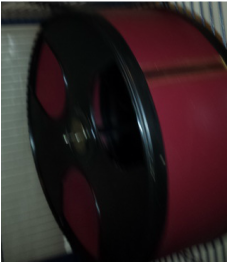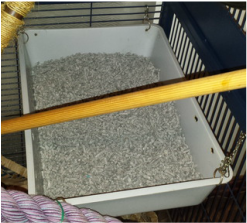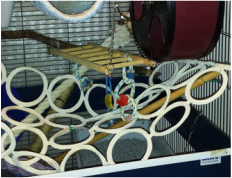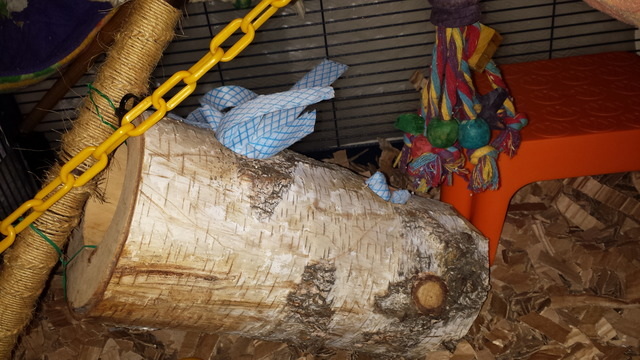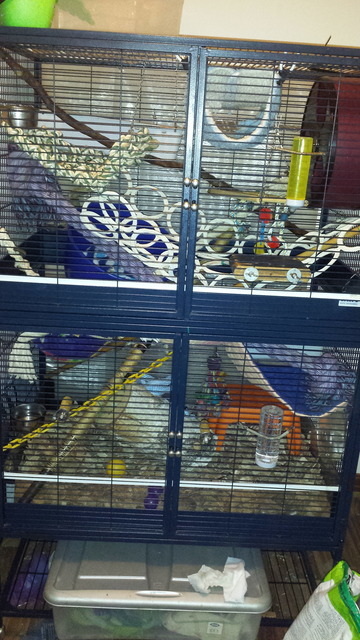Setting up the cage
Working on your first set up, be it in a new cage, or deciding to do something a bit different, can be daunting. You’re faced with a big empty space that you’ve somehow got to make the most of. The first thing to say on this is don’t immediately think you’re going to get it right first time. It takes time to learn how best to set up a new space, be that a cage or a hutch for example. However approach it in the right way and you can get a lot closer first time. Here’s my approach to setting up a cage each time.
1, Key items – there are a few items in each cage set up which are either a pain to move around, or large and cumbersome so can only go in a few places. For me these are usually the wheel (or wheels, I have been known to have 2 in a cage) and digging box if I’m using one, sometimes I might add a set of mini drawers or a large hanging bed. Other than the wheel these don’t always go in and I try to stick to only 2 or 3 large items. When they do they become the first things that go in. I try and vary the location a bit from the obvious, my wheel often goes near the top (as this is where they spend a lot of their time), or by where they wait to be fed or got out (my rats are fans of “why are we waiting” running), a digging box often gets hung unless it contains very heavy soil, to maximise floor space in the cage. My largest branch or rope then goes in to add a bit of structure to hang other things off (I have an SRS which is lacking in places to attach things to on the front of the cage).
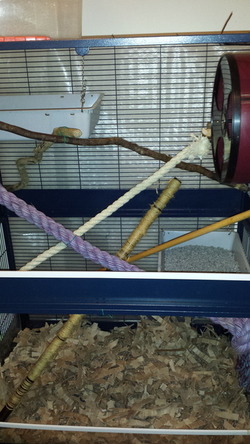
2, Large Platforms – I use hanging litter trays rather than shelves (adapted cat litter trays with key ring clips, hanging corner litter trays or just converted plastic boxes) as these are a lot better at keeping the smell down and extend the foraging area much more. For a large SRS I aim for roughly 2 platforms as these gives me plenty of space to fill the rest with things to do, rather than just sit on. I aim for one about middle of the cage, and one at the bottom. For a cage under about 90cm tall I would only use 1 platform as otherwise you fill the space too much.
3, Structure- this is particularly important in large open cages like my SRS. Often the cages are impractical to fasten things from one side to the next. This being the case I use a lot of branches, parrot toys and ropes to create a central network of places to both hang things and climb up. I will often use a central branch as I have one large branch that fills the entire opened up SRS, but do also regularly do set ups using interlaced smaller branches. I rely heavily on garden wire to fasten each branch together to make the set up stable enough to hang things off. I don’t fill every corner of the cage at this point, just create enough structure in the middle to allow me to maximise the use of the cage
3, Structure- this is particularly important in large open cages like my SRS. Often the cages are impractical to fasten things from one side to the next. This being the case I use a lot of branches, parrot toys and ropes to create a central network of places to both hang things and climb up. I will often use a central branch as I have one large branch that fills the entire opened up SRS, but do also regularly do set ups using interlaced smaller branches. I rely heavily on garden wire to fasten each branch together to make the set up stable enough to hang things off. I don’t fill every corner of the cage at this point, just create enough structure in the middle to allow me to maximise the use of the cage
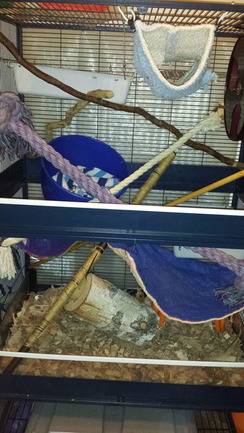
5, Hanging toys – I then add a few interesting objects and toys, there are typically hanging food baskets, parrot foraging toys and interesting balancing toys, I spread these around the cage in harder to reach areas.
4, Sleeping places – I then add a few different sleeping places, I tend to put one on the bottom floor of the cage (for older rats or should anyone fall and injure themselves) but this is rarely used in the warmer months. Then I add 2 or 3 hammocks and a hanging nest or two. You want enough to offer the rats a choice (understanding they are probably all going to try and sleep in the same one a good chunk of the time) but not enough to dominate the cage
|
6, Connections – I go over and connect up all the spaces using ropes, smaller branches and perches. These are usually the more challenging balancing and climbing toys I have, so can be a little wobbly or narrow, or very vertical. Once finished there is a fair network of ropes, perches and branches but with enough space for them to jump around as a quicker method too. Usually at this point I spot a corner of the cage I just haven’t used well so may stick a parrot toy, nesting box or hammock in to fill the space. Throughout it all I try and allow at least 20cm between items to make sure there’s space for them to move around.
|
7, Finishing touches – I then go round and add their water bowls and bottles, usually making sure there’s at least one at the top and bottom of the cage and that there’s at least 2-3 drinking options in each cage. I also make sure the wheel is easy access and exit to encourage use. I then add a few “floor toys” these are toys like balls, toilet roll tubes, gnawing toys and such that add a bit of interest and reasons to investigate. Then I often have a quick wander round the garden or house for some exciting extras, these can be a few sticks of bamboo, some edible leaves, an interesting paper bag, or some nuts in their shells. These get dotted around the cage to add a bit of extra excitement
8, Add Rats! – At this point I put the rats back in and settle back to watch the chaos (when I should be tidying up the bomb site my rat room has become). This is particularly important when I have rats new to my kind of set up, or older rats that are struggling to get around. By watching them I can see them figure out how to get from A to B and make sure they can reach most places without too much difficulty (I want them to push themselves but not be put off). Generally all my rats will try and get everywhere within the first 10 minutes of being in a new cage set up, as they get that excited. I give it a little while then go an patch up the mistakes that I’ve inevitably made, maybe a jump that’s a bit to wobbly, or a branch they manage to dislodge, or a space that they can’t really use.
Making it easier
I will say that this is all a lot easier with a limited number of rats and groups, I typically spend a couple of hours faffing around with my cage, though as it’s not very heavily populated and doesn't have shelves I can leave a full clean out for every 3 weeks. If needed though I can get a cage set up and cleaned out in 30 mins or so even with a SRS. With a bit of practice and smaller cages this could probably be made faster. I have also come across a useful approach for someone with multiple similar sized groups and cages/hutches. This involved keeping a certain amount of fixed set up and alternating the rats from one cage to another every clean out, an easier way to get lots of variety into an environment with more groups of rats and minimising your set up time.
